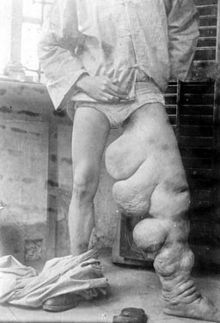Wuchereria bancrofti
| Wuchereria bancrofti | ||||||||||||
|---|---|---|---|---|---|---|---|---|---|---|---|---|

Wuchereria bancrofti |
||||||||||||
| Systematics | ||||||||||||
|
||||||||||||
| Scientific name | ||||||||||||
| Wuchereria bancrofti | ||||||||||||
| ( Cobbold , 1877) |
Wuchereria bancrofti is a representative of the roundworms that live parasitically in the lymphatic vessels of humans. The animal was named after the German-Brazilian doctor Otto Wucherer and the British-Australian doctor and scientist Joseph Bancroft . It causes inflammation of the lymph vessels and lymph nodes .
distribution
They are mainly found in China, America, Asia, Africa and the Pacific. They occur there in the tropical regions.
features
The female reaches a length of up to 10 cm. Their thickness is only up to 0.3 millimeters.
Life cycle
The worms are transmitted by mosquitoes , especially the mosquitoes of the genera Culex , Anopheles and Aedes . The larvae are injected into the stab wound of the animals or actively migrate into the wound and are then mostly passively flushed into the capillaries of the lymphatic vessels. The adult worms can live in the lymphatic system for several years and their females produce huge amounts of new worm larvae, microfilariae , during this time . The larvae enter the peripheral blood mainly at night, from where they can re-infect the intermediate host (the mosquito).
Harmful effect
Mild courses only lead to recurrent lymphadenitis and lymphangitis . Severe courses develop into filariasis , known as elephantiasis tropica. This is a monstrous lymphedema , which is caused by clogging of the peripheral lymph vessels, caused by developing larvae in the vascular lumen. Visible signs of this disease are extreme growths of the connective tissue in the arms and legs, on the genitals and the breasts . Acute symptoms do not appear until 16 months after infection, but these last for days to weeks. This leads to the described swellings, but these generally recede; they only remain in severe forms.
therapy
In the case of lymphatic filiosis, the following medications can be considered: diethylcarbamazine , albendazole and ivermectin . In Papua New Guinea , treatment with diethylcarbamazine, albendazole, and ivermectin (triple combination) achieved better results than diethylcarbamazine and albendazole (double combination) in patients with Wuchereria bancrofti infection. After the administration of the triple combination, almost all patients were free of microfiliars in the blood after 3 years. Treatment was with 200 μg ivermectin per kg body weight, 6 mg diethylcarbamazine per kg body weight and 400 mg albendazole as a single dose. Side effects were fever in 34%, fatigue in 20%, headache in 17%, muscle pain in 12%, nausea or vomiting in 10%, and pain or swelling of the testicle in 10%.
swell
- H. Mehlhorn, G. Piekarski: Outline of parasite science. 6th edition, Heidelberg 2002.
Individual evidence
- ↑ Christopher L. King, James Suamani, Nelly Sanuku, Yao-Chieh Cheng, Samson Satofan: A Trial of a Triple-Drug Treatment for Lymphatic Filariasis . In: New England Journal of Medicine . November 7, 2018, doi : 10.1056 / NEJMoa1706854 , PMID 30403937 , PMC 6194477 (free full text) - ( nejm.org [accessed February 2, 2019]).

